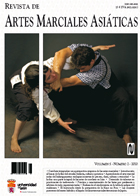Aprendendo a arte marcial índia de kalarippayattu: ecologias incertas de género, classe, cultura e etnicidade
DOI:
https://doi.org/10.18002/rama.v5i2.110Palavras-chave:
Relações inter-culturais, relações professor-aluno, guru, discípulo, contacto físico, contacto verbalResumo
Com base na experiência de campo da autora no estudo da arte marcial tradicional da índia de kalarippayattu, este artigo examina as complexidades da comunicação, incluindo a utilização do tacto como ferramenta educativa, numa relação inter-cultural professor-aluno, e destaca como o género, a cultura e a classe têm um enorme impacto na aprendizagem desta forma “vermelha” de arte.Downloads
Métricas alternativas
Referências
Anti-Defamation League. (2003). Unraveling anti-Semitic 9/11 conspiracy theories. New York: Gorowitz Institute. Consultado el 20 de abril de 2010 de www.adl.org/anti_semitism/9-11conspiracytheories.pdf
Behar, R. (1996). The vulnerable observer: Anthropology that breaks your heart. Boston: Beacon Press.
Chiang, L. (1994). Beyond the language: Native Americans’ nonverbal communication. (ERIC Document Reproduction Service No. ED 368540). Consultado de la base de datos ERIC.
Churchill, C. (1968). The marriage of Toby’s idea of Angela and Toby’s idea of Angela’s idea of Toby. Obra teatral no publicada.
Classen, C. (1993). Worlds of sense: Exploring the senses in history and across cultures. New York: Routledge.
Cooks, L., & LeBesco, K. (2006). Introduction: The pedagogy of the teacher’s body. The Review of Education, Pedagogy, and Cultural Studies, 28: 233-238.
Freedman, D., & Holmes, M. (Eds.) (2003). The teacher’s body: Embodiment, authority, and identity in the academy. Albany: State University of New York Press.
Geurts, K. (2002). Culture and the senses: Bodily ways of knowing in an African community. Berkeley: University of California Press.
Johnson, T. (2006). Performing a/sexual teacher: Cartesian duality in education. The Review of Education, Pedagogy, and Cultural Studies, 28: 253–266.
Kale, P. (1970). The guru and the professional: The dilemma of the secondary school teacher in Poona, India. Comparative Education Review, 14(3): 371– 376.
Lave, J. (1977). Cognitive consequences of traditional apprenticeship training in West Africa. Anthropology and Education Quarterly, 8(3): 177–180.
Light, R. (2001). The body in the social world and the social world in the body: Applying Bourdieu’s work to analyses of physical activity in schools. Consultado el 15 de julio de 2009 de http://www.aare.edu.au/01pap/lig01450.htm
Ness, S. (1992). Body, movement, and culture: Kinesthetic and visual symbolism in a Philippine community. Philadelphia: University of Pennsylvania Press.
Neuman, J. (2005, 21 de octubre). History of the world, Part 2: Jewish conspiracy theory: The satire. Slate. Consultado el 20 abril de 2010 de http:// www.slate.com/id/2128525/
Osella, C., & Osella, F. (1998). Friendship and flirting: Micropolitics in Kerala, South India. Journal of the Royal Anthropological Institute, 4(2): 189–206.
Pitton, D., Warring, D., Frank, K., & Hunter, S. (1994). Multicultural messages: Nonverbal behaviors in the classroom. (ERIC Document Reproduction Service No. ED362519). Consultado de la base de datos ERIC.
Radford, J. (2009, agosto). Word searches: On the use of verbal and non-verbal resources during classroom talk. Clinical Linguistics and Phonetics, 23(8): 598–610.
Sapon-Shevin, M. (2009). To touch and be touched: The missing discourse of bodies in education. En H. Shapiro (Ed.), Education and hope in troubled times: Bold visions of change for our children’s world (168–183). New York: Routledge.
Stahl, R. (1994). Using “think-time” and “wait-time” skillfully in the classroom (informe de mayo de 1994). (ERIC Document Reproduction Service No. ED30885). Bloomington, IN: ERIC Clearinghouse for Social Studies/Social Science Education.
Tincani, M., & Crozier, S. (2007, 25 de septiembre). Comparing brief and extended wait-time during small group instruction for children with challenging behavior. Journal of Behavioral Education, 16: 355–367. Consultado de la base de datos ERIC.
Zarrilli, P. (2000). When the body becomes all eyes: Paradigms and practices of power in kalarippayattu, A south Indian martial art. Oxford: Oxford University Press.
Downloads
Publicado
Como Citar
Edição
Secção
Licença
Direitos de Autor (c) 2012 Sara K. Schneider

Este trabalho encontra-se publicado com a Licença Internacional Creative Commons Atribuição-NãoComercial-CompartilhaIgual 4.0.
Os autores que publicam nesta Revista estão de acordo com os seguintes termos:
- Os autores cedem, de forma exclusiva, os direitos de exploração (reprodução, distribuição, comunicação pública, transformação) à Universidade de Léon, podendo estabelecer, em separado, acordos adicionais para a distribuição não exclusiva da versão do artigo publicado na Revista (por exemplo: alojar no repertório institucional ou publicá-lo num livro), com o reconhecimento da publicação inicial nesta Revista.
- O trabalho encontra-se na Creative Commons Attribution-Non Commercial-Share Alike 4.0 International License. Pode-se consultar aqui o resumo e o texto legal da licença.
- Permite-se, e sugere-se, que os autores difundam electronicamente as versões pré-impressão (versão antes de ser avaliada) e pós-impressão (versão avaliada e aceite para publicação das suas obras antes da sua publicação), favorecendo a sua circulação e difusão, e com ela o possível aumento da sua citação e alcance pela comunidade académica.











